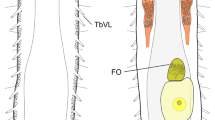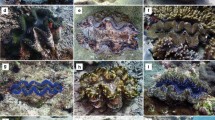Abstract
Veneridae, a cosmopolitan and ubiquitous family in world-wide littoral environments, lists more than 500 species, many of which are often subject to intensive commercial exploitation due to their numerical dominance in benthic communities. Historically, the family has been divided into 12 subfamilies by M. Keen and, even though this taxonomical arrangement was adopted for convenience and does not necessarily reflect genetic relationships, as suggested by Keen herself, this classification is still accepted. To contribute to clarify the systematics and phylogeny of Veneridae, the portion of the nucleotide sequence corresponding to domains IV and V of the gene encoding the large subunit of mitochondrial ribosomal RNA was analysed in 14 species representative of 10 genera belonging to 6 different subfamilies. The results obtained using the maximum-parsimony and neighbour-joining methods indicate that the current placement of the genera into subfamilies does not always reflect a natural subdivision. In addition, the six species of Tapetinae studied, though confirmed to be a monophyletic clade, do not exhibit a correct attribution at the genus level.



Similar content being viewed by others
References
Ansell AD (1961) The functional morphology of the British species of Veneracea (Eulamellibranchia). J Mar Biol Assoc UK 41:489–515
Ansell AD, Trueman ER (1967) Burrowing in Mercenaria mercenaria (L.) (Bivalvia, Veneridae). J Exp Biol 46:105–115
Bedulli D, Castagnolo L, Ghisotti F, Spada G (1995) Checklist delle specie della fauna italiana, 17. Mollusca. Calderini, Bologna
Canapa A, Marota I, Rollo F, Olmo E (1996) Phylogenetic analysis of Veneridae (Bivalvia): comparison of molecular and paleontological data. J Mol Evol 43:517–522
Carter JG, Aller RC (1975) Calcification in the bivalve periostracum. Lethaia 8:315–320
Cesari P, Pellizzato M (1985) Molluschi pervenuti in laguna di Venezia per apporti antropici volontari o casuali. Acclimatazione di Saccostrea commercialis e di Tapes philippinarum. Boll Malacol 21:237–274
DeSalle R, Wray C, Absher R (1994) Computational problems in molecular systematics. In: Schierwater B, Streit B, Wagner GP, Desalle R (eds) Molecular ecology and evolution: approaches and applications. Birkhäuser, Basel, pp 353–370
Devauchelle N (1990) Sexual development and maturity of Tapes philippinarum. Tapes philippinarum: biologia e sperimentazione. ESAV:47–62
Fisher-Piette J, Métivier B (1971) Révision des Tapetinae (Mollusques bivalves). Mem Mus Natl Hist Nat Ser A Zool 71:1–106, 41 plates
Giribet G, Wheeler WC (1999) On gaps. Mol Phylogenet Evol 13:132–143
Gwo JC, Yang WT, Sheu YT, Cheng HY (2002) Spermatozoan morphology of four species of bivalves (Heterodonta, Veneridae) from Taiwan. Tissue Cell 34:39–43
Harte ME (1992) A new approach to the study of bivalve evolution. Am Malacol Bull 9:199–206
Harte ME (1998) Superfamily Veneroidea. In: Beesley PL, Ross GJB, Wells A (eds) Mollusca: the southern synthesis. Fauna of Australia, vol 5. CSIRO, Melbourne, pp 355–362
Holme NA (1961) Shell form in Venerupis rhomboides. J Mar Biol Assoc UK 41:705–722
Jeffreys AJ, Flavell RA (1977) A physical map of the DNA flanking the rabbit ß-globin gene. Cell 12:429–439
Keen M (1969) Veneridae. In: Moore RC (ed) Treatise on invertebrate paleontology. The Geological Society of America and University of Kansas Press, Lawrence, pp 671–688
Kimura M (1980) A simple method for estimating evolutionary rate of base substitutions through comparative studies of nucleotide sequences. J Mol Evol 16:111–120
Knight A, Mindell DP (1993) Substitution bias weighting of DNA sequence evolution and the phylogenetic position of Fea's viper. Syst Biol 42:18–31
Mindell DP, Honeycutt RL (1990) Ribosomal RNA in vertebrates: evolution and phylogenetic applications. Annu Rev Ecol Syst 21:541–566
Palumbi SR, Martin A, Romano S, McMillan WO, Stice L, Grabowski G (1991) The simple fool's guide to PCR. University of Hawaii Press, Honolulu
Phillips A, Janies D, Wheeler W (2000) Multiple sequence alignment in phylogenetic analysis. Mol Phylogenet Evol 16:317–330
Saitou N, Nei M (1987) The neighbour-joining method: a new method for reconstructing phylogenetic trees. Mol Biol Evol 4:406–425
Shimamoto M (1986) Shell microstructure of the Veneridae (Bivalvia) and its phylogenetic implications. Sci Rep Tohoku Univ 56:1–39
Shimamoto M (1996) Phylogenetic implications of shell microstructures and amino acid compositions in the Veneridae (Bivalvia, Mollusca). Bull Inst Oceanogr (Monaco) 14[spec issue]:263–270
Swofford DL (1998) PAUP*. Phylogenetic analysis using parsimony, version 4.10. Sinauer, Sunderland, Mass.
Taylor JD, Kennedy WJ, Hall A (1969) The shell structure and mineralogy of the Bivalvia. Introduction. Nuculacea–Trigonacea. Bull Br Mus (Nat Hist) Zool Suppl 3:1–125
Thompson JD, Higgins DG, Gibson TG (1994) CLUSTAL W: improving the sensitivity of progressive multiple sequence alignment through sequence weighting position-specific gap penalties and weight matrix choice. Nucleic Acids Res 22:4673–4680
Acknowledgements
We thank Prof. E. Olmo for help in preparation of the manuscript, and M. Taviani for the facilities to obtain Mediterranean Veneridae during the "Lophelia Millenium" cruise (December 1999–January 2000). We also thank two anonymous reviewers for their helpful comments on a previous draft of the manuscript. We declare that the experiments we performed comply with the current laws of Italy. This study was financed by MURST (Ministero dell'Università e della Ricerca Scientifica e Tecnologica).
Author information
Authors and Affiliations
Corresponding author
Additional information
Communicated by R. Cattaneo-Vietti, Genova
Rights and permissions
About this article
Cite this article
Canapa, A., Schiaparelli, S., Marota, I. et al. Molecular data from the 16S rRNA gene for the phylogeny of Veneridae (Mollusca: Bivalvia). Marine Biology 142, 1125–1130 (2003). https://doi.org/10.1007/s00227-003-1048-1
Received:
Accepted:
Published:
Issue Date:
DOI: https://doi.org/10.1007/s00227-003-1048-1




